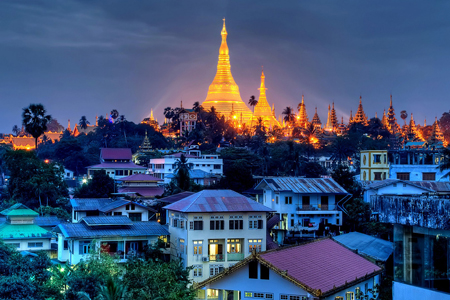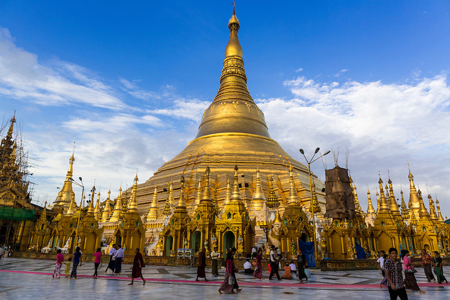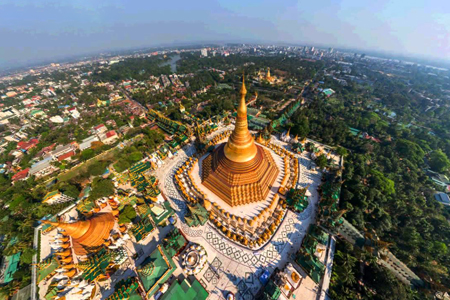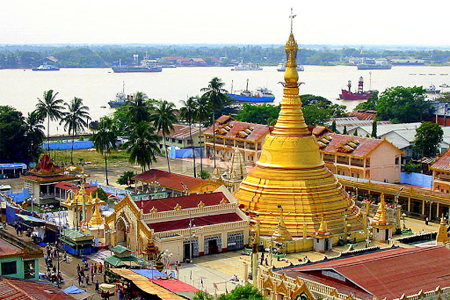After his conquest of Lower Myanmar in 1755, King Alaungpaya renamed the small old town of Dagon as Yangon (end of strife) and founded a new city on the old site. Yangon (Rangoon) soon became a seaport when Syriam was destroyed by the king in 1756 as it had been the center of European interests in the country. Its gradual development as a prosperous town and its elevation to the important status of the capital city of Myanmar are in fact events of recent times. Though it is now quite modern popular tradition traces back its history to the 11th century and its existence under classical names to more than two thousand years.

The history of Yangon is closely associated with that of the Shwedagon pagoda. The place was known as Asitanjana or Okkala some five hundred years before the Christian era. According to the hoary legend two merchants, Taphussa and Bhallika from Okkala went to India on a trading venture. They met the Buddha under the sacred Bo tree and offered Him honey cakes. Having partaken of the cakes presented by them the Buddha bestowed on them eight sacred hairs from His head. On their return they were deprived of two hairs by the king of Ajetta and another two by the king of the Nagas. Arriving at Okkala they were greeted by King Qkkalapa who held a great festival in honor of the sacred relics. With the help of Sakka, king of gods, a site on the Theinguttara hill outside the gates of Asitanjana was selected to lay the foundation of a pagoda for enshrining the relics. On excavation of the site, relics of the three preceding Buddhas, namely the staff, the water-dipper, and the lower garment were recovered. These were buried again with the sacred hairs brought by the two brothers. When the relics were examined before placing in the vault the casket was miraculously found to contain the original number of eight hairs. Over the relic, the chamber was erected a golden pagoda enclosed in a silver one which in turn was enclosed by a series of tin, copper, lead, marble and iron pagodas. Finally, a brick pagoda was built to encase the whole series of smaller pagodas. It was only twenty-seven feet high.
The importance of the town grew with that of the Shwedagon pagoda. King Byinnya-U of Hanthawaddy raised it to a height of sixty-six feet in 1362. Yangon was still a small town but it was regarded as a religious center. Several kings enlarged, repaired or regilt the pagoda in succession and when Shinsawbu (1453-72) came to the throne at Bago she performed the pious act of building over it a still higher pagoda assuming more or less the present shape. She also gilded the pagoda from top to bottom for which she offered gold by her weight. After she raised Dhammaceti king, Shinsawbu retired to Yangon and during her last illness, she had her bed placed so that she could set her eyes upon the gilded pinnacle of the great pagoda.
Dhammaceti, also a pious ruler, gilded the pagoda with gold four times his weight and the weight of his queen and set up an inscription telling the legend of the Shwedagon in Myanmar, Mon and Pali. In 1774 when Hsinbyushin of Innwa put up a new hti (Umbrella) the pagoda attained its present height. The hti was replaced by yet another new one by Mindon in 1871.

The Shwedagon pagoda today is 326 feet high, with a square plinth the perimeter of which being 1,420 feet. Visiting the sacred from a Yangon tour, you will discover the base is surrounded by 64 small pagodas with four larger ones in the center of each side. Above the base are three terraces receding in successive planes and having seven angular projections between the main sides facing the cardinal points. Next rises the bell-shaped superstructure followed by the dome in the form of an inverted bowl. Then come the multiple moldings, two bands of ornamental lotus divided by a ring of spherical bosses (ywai), and the spire shaped like a plantain bud. The latter is surmounted by the hti (umbrella), an insignia of great sanctity, gilded and covered with precious stones. The pinnacle of the hti is made up of a bejeweled vane and the crowning diamond bud.
The platform on which the pagoda stands is reached by four long flights of steps, the entrance to the southern approach being guarded by two huge leogryphs 30 feet high. On the platform are several shrines and prayer halls some of which are decorated with very fine wood carvings and mosaic work. Two huge bells were dedicated and placed in prominent pavilions. One weighing about 40 tons was donated by King Tharrawaddy in 1841, and the other weighing 16 tons by Singu Min in 1778.

Among the ancient pagodas to visit in Yangon are the Sule Pagoda and the Botataung Pagoda. The Sule is also believed to be over two thousand years old. Its sanctity is due to the sacred hair relic enshrined therein. Two Buddhist missionaries, Sona and Uttara, brought over from India ten hair relics and other sacred relics to Thaton (Suvarnabhumi). They presented one hair relic to Maha Sura, a minister at Yangon. The pagoda built by him was named Kyaik Athok in Mon and was also known as Sura Ceti in Myanmar. Its height is 152 feet above the platform. The peculiarity of its architecture is that the octagonal shape is maintained as it tapers to the bell and inverted bowl. The original structure of the Botataung also goes back to over two thousand years. It enshrines two corporeal relics of the Buddha and a sacred hair. It was erected by a minister who received the relics distributed by the King of Suvannabhumi. The latter obtained the relics from a Buddhist missionary of eight monks from India. Known as Kyaik-de-at, the pagoda was destroyed during the last war and the present structure was erected by public donations at the same spot.
Today no religious edifice in its original form is to be seen at Yangon. Archaeological excavations just before the last war brought to light the remains of an old vaulted structure housing some laterite images of Buddha. It lies at Tadagale in the northern outskirts of the present city. A votive tablet with Pali inscription of 12- 13th century was among the antiquities recovered from the site. A few other objects like bronze statuettes and votive tablets belong to the 11th century if not earlier. Devout Buddhists have since encased the whole structure in a new pagoda of modem design named Naga Hlaing-gu and the vestiges of ancient Yangon are now lost to view.
Despite the hoary traditions attached to the celebrated pagodas at Yangon, these edifices are now cloaked, somehow or other, in mantles of modernity. Yet in the fast-growing city, they still retain the splendor and sanctity, distinguishing themselves as true and glorious symbols of Yangon’s bygone past.

